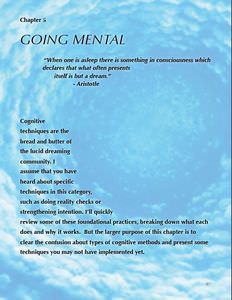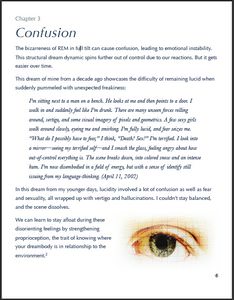Lucid Immersion Blueprint Review
 This is my review of the digital course
The Lucid Immersion Blueprint
by Ryan Hurd.
This is my review of the digital course
The Lucid Immersion Blueprint
by Ryan Hurd.
Ryan is the creator of the website Dream Studies. I have followed his blog for a few years and think of Ryan as a very well educated lucid dreamer (he has a Masters in Consciousness Studies) and possessing a deeply poetic perspective of the dreaming mind.
Ryan has a way of balancing objective scientific insight with spiritual self-inquiry. He emphasizes the need to take a holistic approach to lucid dreaming and remains in awe of the extraordinary potential for self-growth. Though he doesn't claim to be any kind of expert or "guru" in lucid dreaming, I think he makes an inspiring tutor with ample personal experience to draw from.
Style and Context
Ryan's science-and-spirit approach is the continuing theme in Lucid Immersion. This is not your run-of-the-mill beginner's guide to lucid dreaming but something far more unique in its approach.
His story begins with a month-long jaunt in Nicaragua, where the conditions of travel ignited his lucid dream life. His anecdote holds a number of truths for lucid dreamers: how changes in sleep patterns, escaping the daily grind, and being more mindful can trigger any number of highly vivid and conscious dreams.
Though understated, this example already gives the reader an informal framework to begin their own dream studies. This is Ryan's teaching style across the board; he paints a picture of scientific and personal observations, picking out pertinent details, and then lets the reader decide what lessons to take home.
Some people may be too impatient to allow this approach to play out - instead preferring to be spoon-fed practical instructions. But given the nature of our quest, I think a lot of people will enjoy Ryan's reflective yarns and find this an all-round more memorable jaunt into lucid dream induction.
The Lucid Immersion Blueprint (Essential Edition)
In the main 180-page illustrated ebook, The Lucid Immersion Guidebook, you'll learn about the latest research in lucid dreaming plus Ryan's original method for immersing your mind, body and spirit into your dream life.
- BUILDING THE FOUNDATION (p 15-35) teaches essential basics like good sleep habits, understanding REM sleep, improving dream recall, recording your dreams without judgment, dietary tips, and even when not to pursue lucid dreaming (such as in the aftermath of trauma).
- SCIENCE OF LUCID DREAMING (p 38-62) depicts the language of dreams, their emotional intensity, co-creative dream theory, letting go of control, the traits of lucid dreamers, and how the lucid immersion program works.
- THE LUCID IMMERSION METHOD (p 67-80) explains what makes the immersion method work: the paradox of trying too hard, the culture of lucid living and waking awareness, dream incubation in the ancient world, and uniting the mind, body and soul (emotions) in lucid awareness.
- PERPARING FOR THE IMMERSION (P 82-85) is a short chapter advising on some internal and external preparations: creating the bedroom sanctuary, and taking lucid dreaming seriously while maintaining a sense of playfulness.
-
 GOING MENTAL
(p 87-101) is a discussion of cognitive techniques for lucid
dreaming, such as strengthening the intention, mindfulness, day
residue, dreamsigns, advanced journaling, video games, binaural
beats, meditation, Dream Yoga, daydreaming, and subtle mind
programming.
GOING MENTAL
(p 87-101) is a discussion of cognitive techniques for lucid
dreaming, such as strengthening the intention, mindfulness, day
residue, dreamsigns, advanced journaling, video games, binaural
beats, meditation, Dream Yoga, daydreaming, and subtle mind
programming.
- GETTING EMOTIONAL (p 103-116) deals with the soulful side of lucid dreaming: developing emotional intelligence, eliminating negative expectation, "touching the shadow" (projecting feelings onto other dream figures), day review, Scott Sparrow's Dream ReLiving, and meditation in the lucid void.
- FINDING BALANCE (p 121-148) refers to physical health for lucid dreaming which Ryan isolates as: advanced sleep practices, body meditations, active sound entrainment practices, and The Lucid Diet (including the safe use of supplements). Other intriguing practices include the Threshold Exercise and Nature Awareness.
- YOUR IMMERSION PLAN (p 151-162) provides a way to put all your newfound knowledge together, starting with any 3-6 lucid practices. Once the immersion is over, you'll rest for a week, then launch the next stage which may take the form of travel immersion, home alone, wilderness, with peers, or even experimental immersions.
At the end of the book Ryan lists his recommended lucid practices which really underlines the holistic nature of his approach. You won't find any quick-fire solutions or magic pills (as if such things exist) but rather a strategic plan for achieving lucidity through mental, physical and emotional lifestyle changes.
There are some famous lucid dreaming techniques he has deliberately omitted, such as a visualization method for Wake Induced Lucid Dreams, or details of the Wake Back to Bed technique. These, Ryan points out, have been covered by predecessing lucid dreaming works (which he encourages you to read); the Immersion course is dedicated to teaching his own original path to lucidity.
Meanwhile, the Workbook for Lucid Immersion is a printable 17-page PDF which launches your immersion training by encouraging you to reflect and write about your background, beliefs and values. It also launches your meditation efforts.
The Lucid Immersion Blueprint (Advanced Edition)
 The Advanced Edition contains all of the above plus several
additional features.
The Advanced Edition contains all of the above plus several
additional features.
Overcoming Roadblocks deals with a number of common issues experienced by beginner lucid dreamers. These include dreams that end prematurely or become too emotional, as well as dreams which you can't control nor remember your intention. Ryan also offers advanced advice on dealing with boredom in the dream world, negative expectations, and seeking cognitive flexibility.
Advanced readers will also hear three interviews with experts in lucid dreaming.
In more than two hours of audio interviews, Ryan probes the minds of Robert Waggoner (author of Lucid Dreaming: Gateway to the Inner Self), Chris Olsen (creator of the lucid dreaming documentary Wake Up!) and Tim Post (editor of the website Lucidipedia).
Specific topics under discussion are common roadblocks, belonging to a lucid dreaming group, and incubation methods for conscious dreams. I am really impressed by the extra lengths Ryan went to in securing these interviews and asking questions of the experts that truly provide greater insight.
Other audio bonuses include two lectures delivered by Ryan Hurd himself.
The first is a 20-minute presentation called Lucid Nightmares: The Dark Side of Self Awareness in Dreams. This is a fascinating topic to explore and an area which Ryan has had a great deal of personal intuition.
However, one caveat: if you have never had a lucid nightmare before, I suggest you put this audio aside for now. In lucid dreaming, the expectation principle is powerful and this session may be all it takes to create your own nightmare experience. Of course, lucid nightmares can be valuable and I welcome their insight, however there is such a thing as poking the beehive. Proceed only when you feel ready for the emotional intensity that lucid nightmares can bring.
The second of Ryan's talks is a 40-minute discourse on The History of Lucid Dreaming, bringing together various cultural and philosophical interpretations of conscious dreaming. He finishes with a neat Q&A session with the audience, discussing the link between lucid dreams and OBEs, the most amazing thing you can do in a lucid dream, and how sleep debt affects lucidity.
Final Thoughts
The Lucid Immersion Blueprint is a course of true quality and originality. Ryan applies his unique approach to teaching lucid dreaming through a combination of scientific and spiritual enquiry. How fantastic to find an author with such genuine passion and knowledge for his subject; a true student of lucid dreaming who has dedicated much of his life to understanding its complexities.
There is, I should say, far more information in this course than you actually need to dip your toe in the waters of lucidity. Casual readers may well find this overwhelming, finding it unnecessary to learn about the depths of dream theory and cultural interpretations before experiencing lucid dreaming for themselves.
 However, this is no discredit to Ryan's work. I'm sure there are
many ambitious and advanced dream explorers who will revel in the
depth of information here, which is beautifully packaged.
However, this is no discredit to Ryan's work. I'm sure there are
many ambitious and advanced dream explorers who will revel in the
depth of information here, which is beautifully packaged.
I recommend this course to anyone who has dabbled in the realm of
lucid dreams and now seeks to immerse themselves in the full
intensity of the experience. It is a detailed guide for anyone
willing to commit to a holistic approach to lucid dreaming and all
that it entails. Meditators, philosophers and lovers of nature will
find this route instinctive.
Download The Lucid Immersion Blueprint via Ryan's website.
















